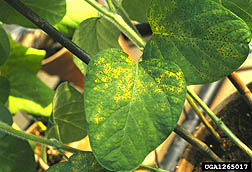This page has been archived and is being provided for reference purposes only. The page is no longer being updated, and therefore, links on the page may be invalid.
|
|
|
|
Scientists Identify Rust Resistance Genes in Soybeans
By Jan SuszkiwMarch 26, 2009
Using state-of-the-art genomics techniques, a team of scientists from the Agricultural Research Service (ARS), Iowa State University (ISU) and Brazil have identified a cluster of soybean genes that provide resistance to the fungus Phakopsora pachyrhizi, which causes Asian soybean rust (ASR). The discovery will help defend the $27 billion U.S. soybean crop against ASR, through conventional breeding or biotechnological means.
ASRwas first detected in the continental United States in 2004. Although fungicide use is effective against ASR, providing farmers with resistant cultivars is more sustainable, according to geneticist Michelle Graham. She's with the ARS Corn Insects and Crop Genetics Research Unit in Ames, Iowa.
Genetic mapping previously linked ASR resistance to five DNA regions, or "loci," within the soybean genome, named Rpp1 through Rpp5. Screening of 15,000 accessions in the ARS soybean germplasm collection revealed how uncommon resistance is: Less than 5 percent of the accessions are resistant.
Graham’s group sequenced the Rpp4 locus and identified a cluster of candidate genes that confer ASR resistance. Comparisons of susceptible and resistant cultivars identified a single candidate gene, Rpp4C4, thought to bestow resistance. Rpp4C4 is one of five nearly identical genes in the Rpp4 locus. Frequent "shuffling" or recombination within the cluster allowed new disease resistance genes to be formed.
For example, soybean cultivar Williams82 has three resistance genes in the cluster and lacks Rpp4C4, making it vulnerable to ASR. However, line PI459025B, the source of Rpp4 resistance, has five candidate genes. “Virus-induced gene silencing" studies were used to turn off the Rpp4 candidate genes in PI459025B, making it susceptible to ASR and confirming the genes’ importance.
Graham, together with Jenelle Meyer, Kerry Pedley and Randy Shoemaker of ARS; Chunling Yang, Chunquan Zhang, Martijn van de Mortel, John Hill and Steve Whitham of ISU; and Ricardo Abdelnoor and Danielle Silva of the Brazilian Agricultural Research Corporation (Embrapa) in Brazil, published their findings recently in the online edition of Plant Physiology.
ARS is the principal intramural scientific research agency of the U.S. Department of Agriculture.

